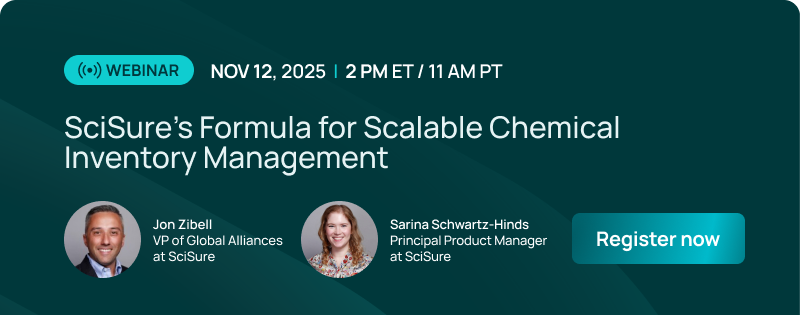Chemical Profiles: The Secret to Safer, Smarter Labs
Discover how incomplete chemical data creates safety blind spots—and why connected chemical profiles are key to lab compliance and efficiency.

Download Whitepaper
The Hidden Gaps in Lab Safety
Every lab manager or EHS leader knows the frustration of having an inventory list yet still has no insight into what those chemicals truly are or how they’re regulated.
That missing layer of context is where safety blind spots begin. When chemical data is fragmented across SDS folders, spreadsheets, or procurement systems, even the most diligent teams spend valuable time chasing information that should be at their fingertips.
What’s often overlooked is that safety, compliance, and operational efficiency all depend on one shared foundation — complete and connected chemical profiles.
1. A name on a label isn’t enough
Listing a substance as acetone or toluene doesn’t tell you if it’s flammable, a peroxide former, or subject to specific MAQ thresholds.
Without that metadata — hazard class, storage compatibility, and SDS linkage — the chemical is simply a label, not a profile.
Why this matters
Inventory management tools that only track container counts or locations fail to provide the full picture regulators expect.
A compliant system should know what a chemical is, how it behaves, and what it affects downstream — from storage configuration to disposal.
Labs that rely on “flat” data spend hours every month verifying details that could be automatically populated and validated.
2. Incomplete data multiplies manual work
When chemical property data isn’t tied to inventory records, staff must manually cross-reference CAS numbers, SDS files, and vendor databases to retrieve hazard details. Each lookup is a point of friction — and each missing flag (like “pyrophoric” or “reproductive toxin”) is a potential compliance risk.
Why this matters
Manual verification might work for 100 containers, but not for 10,000.
Incomplete chemical profiles lead to inconsistent reporting and reactive risk management.
By contrast, systems integrated with a verified chemical property database can automatically build complete profiles — saving hours of effort while reducing the likelihood of missed hazards and reporting errors.
3. Fragmented data creates fragmented compliance
When SDSs, hazard information, and inventory data live in separate systems, you’re managing by copy-and-paste — not by insight.
Every system update becomes an opportunity for misalignment: outdated SDS versions, mismatched hazard codes, or duplicate entries under slightly different names.
Why this matters
Regulators expect traceability — a clear line between what’s in your lab and the data that defines its risks.
Fragmented systems make that impossible, forcing teams into a cycle of reactive corrections instead of continuous readiness.

4. Disconnected systems are the real compliance bottleneck
Most labs don’t struggle because of poor data — they struggle because of disconnected data. SDS repositories, and safety systems often operate independently, meaning updates in one place never flow to another.
Why this matters
This disconnect prevents EHS teams from seeing chemical usage trends, tracking storage limits in real time, or running unified compliance reports.
The more fragmented your system becomes, the harder it is to scale safely.
Modern lab operations are moving toward platforms that connect these functions — automatically syncing intake, hazard data, and compliance reporting to form a seamless end-to-end solution.
Conclusion — The Power of Connected Context
Chemical profiles are more than digital records — they’re the connective tissue of laboratory safety and compliance.
When every chemical in your system carries a complete, verified profile, your lab shifts from confusion to clarity.
Instead of hunting for SDSs or cross-checking spreadsheets, your team can focus on what really matters: creating a smarter, more efficient research environment.
Complete chemical profiles don’t just help you stay compliant — instead of hunting for SDSs or cross-checking spreadsheets, your team can focus on advancing science safely and efficiently. With complete chemical profiles, you gain the insight to anticipate hazards, streamline reporting, and strengthen every compliance decision.

Read more of our blogs about modern lab management
Discover the latest in lab operations, from sample management to AI innovations, designed to enhance efficiency and drive scientific breakthroughs.





